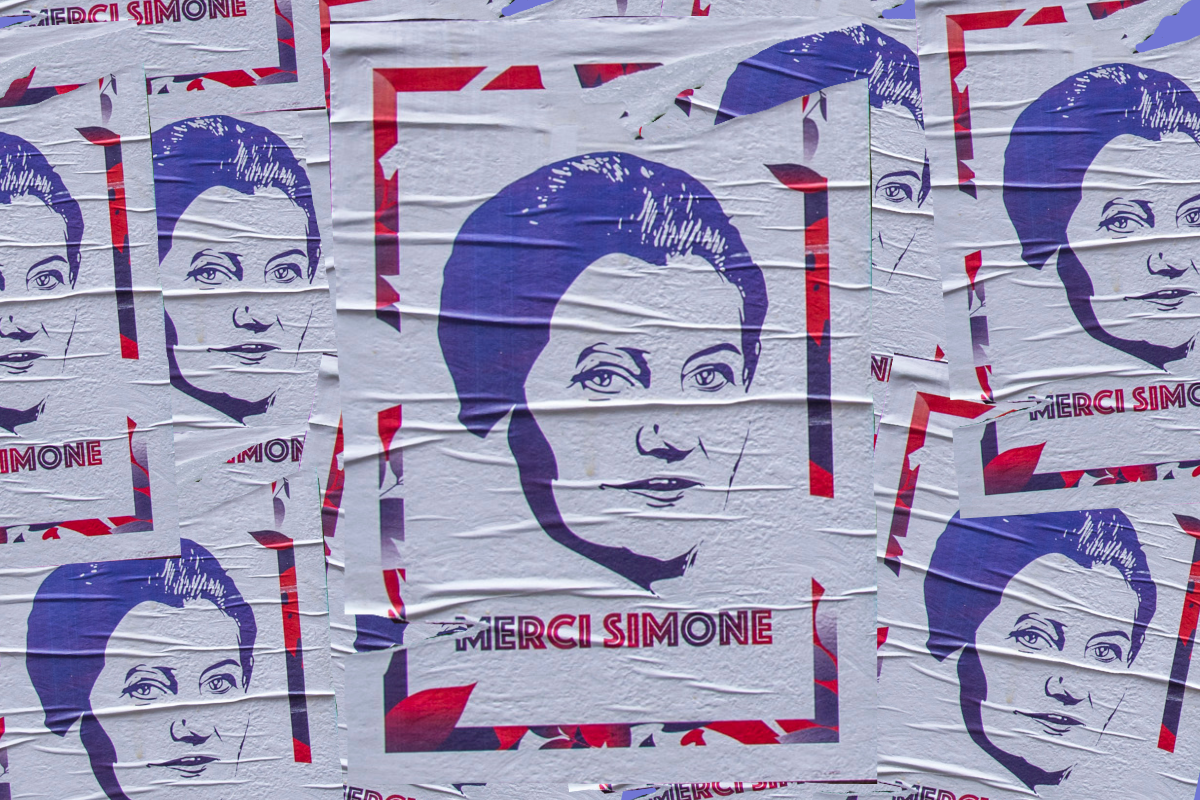In what was either fortuitous or calamitous timing, I introduced the topic for my students’ final oral exam mere days before the Supreme Court’s leaked draft overturning Roe v. Wade: the life of French-Jewish feminist icon Simone Veil, who wrote the 1974 law legalizing abortion in France.
I am a high school French teacher and, like millions of other Americans with uteruses, I have been unable to concentrate or contain my rage since the Supreme Court’s decision to strip us of our most basic rights to bodily autonomy. Last Saturday, one of my French students, Sephora, posted on Instagram, “We need an American Simone Veil.” She’s right.
Simone Jacob was born into a secular Jewish family in 1927 in Nice and had a happy, carefree childhood until the Nazis invaded France in May of 1940. The family initially found themselves in the “free zone” under the collaborationist government situated in Vichy, but when the Nazis invaded the South of France, the Jacob family was forced to split up into different hiding places, each using a fake ID. Despite her not being allowed to attend school, Simone still took the difficult baccalauréat exam, which she passed in 1944 to earn her high school diploma under her real name. She was arrested the next day.
Simone, along with her mother, brother and sister Madeline, were sent to the transit camp of Drancy outside of Paris before being deported to Auschwitz-Birkenau. Out of the six-person Jacob family, only Simone and Madeleine survived. Her experience in the concentration camps laid the groundwork for her future work for human rights.
Upon her return to France, Simone studied law, where she met her future husband, Antoine Veil. Veil was also Jewish, but had taken refuge in Switzerland during the war. They had three sons together, all while Simone actively worked outside the home as a lawyer. After losing her sister in a tragic car accident, Simone passed the competitive national exam to become a magistrate in 1956; her first assignment was prison reform. Soon after, she was appointed Health Minister under President Valéry Giscard d’Estaing.
Most French people know Simone Veil for what came next: She was tasked by the president to write the law which would legalize abortion.
This was no mean feat. In 1967, contraception was made legal — but only after vigorous debate. As Veil recounts in her autobiography “A Life,” “Contraception gave freedom to women and control over their own bodies, taking that away from men. Abortion, however, not only removed women from men’s authority, but killed it” (Veil p. 163).
President Giscard’s choice of Veil to lead the charge for legalizing abortion was ingenious because she understood very well that outlawing contraception and abortion was a simply a way for men to maintain control over women. It was no secret that abortions were happening: Women were often seen crossing the border to the Netherlands, where abortion was legal. But Veil also knew anything that would give women more control over their lives and choices would shake the patriarchal system to its core.
When the text of Veil’s law was made public for debate, she received thousands of letters from the extreme right-wing minority. Her staff destroyed the most vile ones (although Veil quips in her book that these letters would be of some interest to psychologists, as those who wrote them were clearly detached from reality). But it wasn’t only letters. Her apartment building in Paris was defaced with swastikas several times, and she was even attacked in the streets on more than one occasion.
Those who opposed “Veil’s Law,” as it has come to be known in France, often used antisemitism to discredit her. On the floor of the Assemblée Nationale (the French equivalent of the House of Representatives), one deputy likened abortion to “sending a fetus to the crematorium.” Veil, who saw the work of the gas chambers at Auschwitz with her own eyes, persevered in her fight for human rights despite the attacks and threats — a testament not only to her strong moral character, but also to the level of resilience and tenacity that develops when you’ve seen the worst of human behavior.
After the overturning of Roe v. Wade, one of my French friends texted me, “I understand how important Simone Veil was now.” Another French friend added, “Veil had to convince men to care about this.” The president’s focus on abortion’s legalization was not always supported even by members of his own party. Veil reveals in her book that Jacques Chirac (who later went on to become president of France from 1995 to 2007) disliked the Ministry of Health’s focus on abortion, calling it a “women’s problem,” and said that “women have always managed and they will always manage.” When Veil gave a speech on the subject to the Assemblée, there were 400 men present — and only nine women.
For the three days of intense debate, Veil and her colleagues were unsure what the final vote would be. One of her colleagues was so anxious that she said to him, “Jean-Paul, relax. Your life doesn’t depend on this law.” I wonder if this Jean-Paul realized how privileged he was to be in that position, when Veil’s life had been on the line many times, including for this law — not to mention the women whose lives would depend on legal abortion.
Ultimately, Veil’s law passed the Assemblée 284 to 189 and went on to be passed in the Senate. Veil continued as Health Minister until 1979 before becoming first a representative and then the first female president of the European Parliament, where she testified publicly multiple times about the horrors she experienced during the Holocaust.
Despite her extremely long resumé of accomplishments, most people remember Simone Veil for “her” law. Men frequently approached her to say, “My wife really admires you.” Their meaning did not escape Veil: Women admired her, not men. In fact, she went as far as to state that she believed abortion “never really interested men.”
These observations by Veil, written some 30 years after the events, remain pertinent. I, too, am unsure men are interested in abortion, or in what a woman goes through when faced with this decision — and I, too, am suspicious of the motives behind limiting abortion. Veil met with several religious leaders as she wrote the law and found very little confrontation from most of them. Doctors agreed with her that making abortion legal in France would limit the “savage” scenes they had witnessed as women attempted to perform abortions on themselves. What upset most people (read: men) was their loss of control.
Simone Veil remained a target of this rage for the rest of her life. In 2005, a group of ultra-Orthodox rabbis from New York wrote a letter to the President of Poland, condemning his decision to ask Veil to come to the 60th anniversary ceremony of the liberation of Auschwitz because she had written the law legalizing abortion. No matter where she went, people continued to protest “Veil’s Law.”
My student, Sephora, elaborated on her connection to Simone Veil: “Growing up as a female minority and even just being a woman now is such a stressful thing because it’s almost as if we don’t exist. Our rights our continuously disappearing and we need someone to stand up for us and show that we do in fact exist.”
Veil passed away in 2017 and was only the fourth woman to be buried in France’s Panthéon. Several times throughout her autobiography, she recounts how the people she worked with called her “militant”: She was “militant” about prison reform, “militant,” about making abortion legal, “militant” about creating a society where men and women are equal, “militant” about keeping the memory of the Holocaust alive. But if Simone Veil had not been “militant,” nothing would have changed. She had to be “militant” to spark societal change.
I hope we can all learn to be “militant” like Simone Veil — and carry on the fight.



